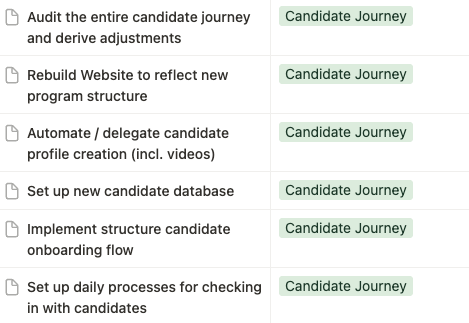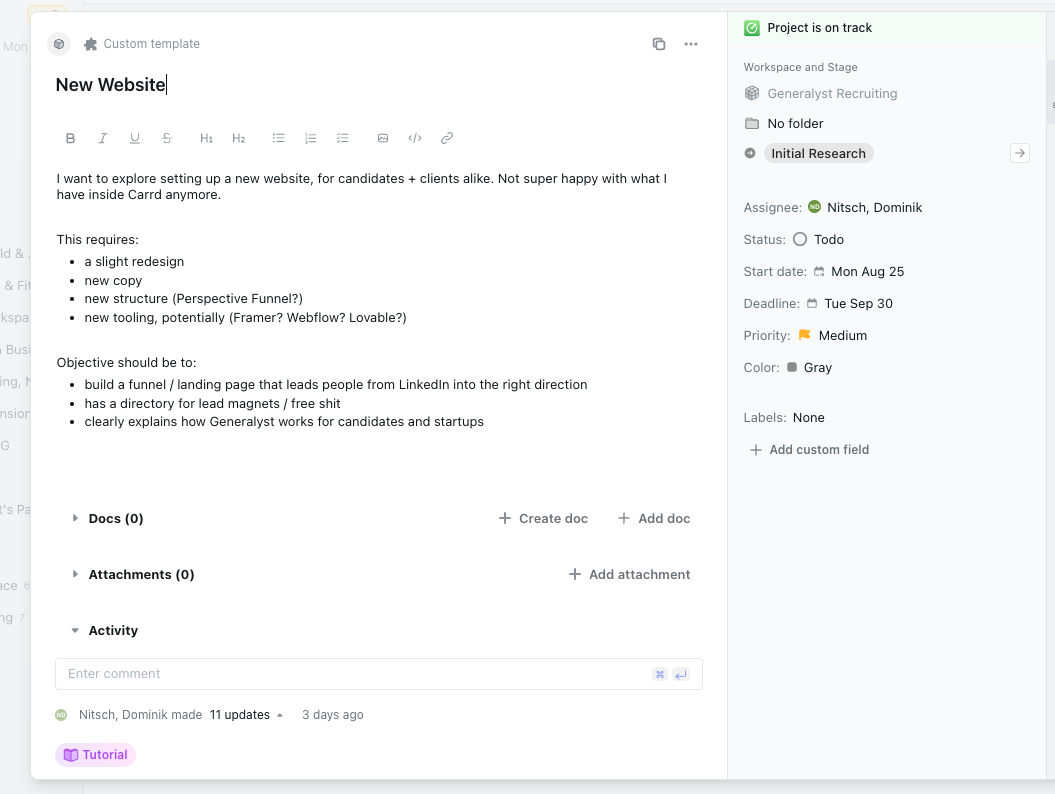Rebuild Your Productivity Stack: Part 1 [#85]
5 steps to go from procrastinating to productive.
![Rebuild Your Productivity Stack: Part 1 [#85]](/content/images/size/w1460/2025/08/How-to-become-a-generalist--49-.png)
Recently, I’ve been feeling frazzled. Unproductive. Spending more time looking at my to-do list than actually working on my to-do list.
Kind of embarrassing for a guy that recorded an entire online course about personal productivity.
Something had to change. This is how I did it, and how you can do it too:
[1] Understand where you’re going
As a solopreneur, I have nobody that holds me accountable: no manager, no investors, no colleagues.
It’s just me. And when I don’t make progress, then no material consequences happen. So I tried to do a bit of everything, which meant the bigger projects never got done in the first place.
For example: for a few months now, I’ve had a “re-build candidate database” on my to-do list. That’s super vague and doesn’t get anyone anywhere. It’s a big project that I never dared to tackle because I didn’t know where to start.
Even worse, I was missing the big picture: I know where to go in the long-term, but haven’t broken down the segments that will get me there.
So the first part of the reset was to map out where I’m going. More specifically: what do I want to have achieved within the next 12 months?
I mapped this out across all dimensions of my life: health, work, play, love.
(Inspiration taken from the book “Designing Your Life”, would strongly encourage you to read it if you’re struggling with the question of where you want to go long-term)
Once I had this, the next step was to figure out where to begin.
[2] Understand where to begin
For the work part, I went back to the good old trusted OKRs (Objectives and Key Results).
So for the next three months, I took all the things currently on my radar and stacked them up:
- How many of them can I realistically do while maintaining operational capabilities?
- What will it take to get each of them done?
I picked four main areas as objectives (which is already a bit too much, if I’m being honest), and then broke down 2-5 key results for each of them.
Here’s an example for the objective run a state-of-the-art candidate acquisition process from my Notion OKR page.

(I don’t want to get too semantic here – the way this is formulated is by no means perfect from a OKR practitioner perspective, but it gets the job done for me.)
For a deeper dive into setting up OKRs for yourself, check out chapter 02.2 in Personal Productivity OS.
Get it here. 30-day money-back guarantee if you don't like it, no questions asked.
All these key results are somewhat achievable, but still too large to be tackled in a single sitting. I still didn’t know where to start.
This is where we get granular.
[3] Break down tasks into their granular components
Let’s take the example of the Generalyst website.
It gets the job done, but based on the questions candidates ask in the interview, it doesn't do a great job at explaining what Generalyst is all about. Conversion on the company side is also terrible.
It’s not urgent (the website works), but it’s important – the website is the gateway to the Generalyst program.
Rebuilding a website is a project. So inside my task management app, I created a new project with three different stages that have different deadlines.

The quarter ends on Sep 30th, so that’s when the project needs to be finished – but the earlier, the better. Knowing the timeline for the project, the next step is to break down the tasks granularly:

Now I know where to start. As you can see, my Motion App (said task management app) has already assigned a time slot to work on these tasks.
These slots might change in the future, but for now, it looks like that two weeks from today, I’ll be busy working on my website.
I did this for everything on my OKR page – smaller key results got broken down into 1-3 tasks, larger ones into standalone, clearly defined projects.
With this huge backlog of clearly defined tasks in place, I felt clarity that I haven't had in a long time.
[4] What about recurring tasks?
When you run a business, there are things that you need to do daily – operational things like pre-screening candidates in my case, processing email, cold calling, you name it.
For this, I have recurring tasks in my task management app that pop up daily.

Just about when you’re reading this newsletter, I’ll be working on the things that I do daily: processing email, checking interview processes, screening candidates that just applied.
With now both recurring and one-time tasks in the system, I now have a clear overview of everything I need to do, in chunks of 0:15 - 2:00 hours. Perfect.
[5] Tooling
I’ve mentioned Motion before. I think it’s perfectly suited for solopreneurs or people in small teams, because it allows me to do all this:
- It syncs with my calendar, so meetings always take precedence.
- Then, the app uses AI to schedule tasks based on priority and deadline
- When a task is finished earlier, it reshuffles the tasks to be best reflect the new structure
- When something takes longer, it reschedules the tasks afterwards as well
Feels like having an executive assistant that keeps me on track. Without having an executive assistant.
I could go very deep here, but for most of you, this wouldn’t be useful if you’re not using Motion.
If you’d be interested in a mini-course about how I set up Motion with all the bells and whistles (been using it for >2 years), please click below. Kit (the tool I’m using to send this newsletter) will tag you accordingly. If enough people sign up, I’ll record a mini-course.
And if you want to get started directly, you can check out Motion here. If you sign up with my affiliate link, I'll give you:
- a 100€ discount on Personal Productivity OS
- free access to the aforementioned Motion mini-course (I'll probably slap a price tag on it, somewhere in the 29€ range)
Call to Action
If you're frazzled and don't know where to start, take 2-3 hours today and do this:
- Map out what you roughly want to achieve in the next 12 months
- Identify 1-3 objectives for the next three months that will help you get there
- Break each of these objectives down into 2-5 key results
- Turn each key results into granular tasks of 0:15 - 2:00 h
- Schedule these tasks into the system of your choice
This will take your productivity from 0 → 10. And this is just the beginning ...
Now, you might still have a few questions:
- How do you execute on this?
- How do you deal with the small things life throws at you in between?
- How do you ensure meetings don't take over your calendar?
- What other tools do you use?
These, and more, are questions I'll answer in next weeks newsletter. Subscribe here if you're not subscribed yet.
That's it. Appreciate your readership.
Now, go out and have a fantastic week.
LFG. 🔥
LinkedIn | Threads | X | Bluesky | Instagram | TikTok | YouTube
Whenever you're ready, there are four ways I can help you:
[1] Reclaim up to 4 hours per day and find time to do the things you've always wanted to do by enrolling into Personal Productivity OS.
[2] Hire your next Founder's Associate or other business generalist position with my startup, Generalyst Recruiting.
[3] You could also find your next startup job in Europe by simply applying as a candidate.
[4] Learn how you can build your career as a generalist by subscribing to this newsletter. ⬇️
Dominik Nitsch Newsletter
Join the newsletter to receive the latest updates in your inbox.